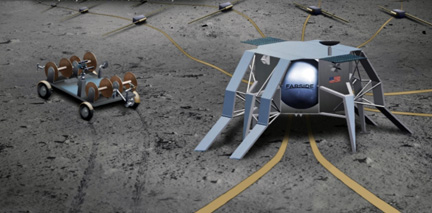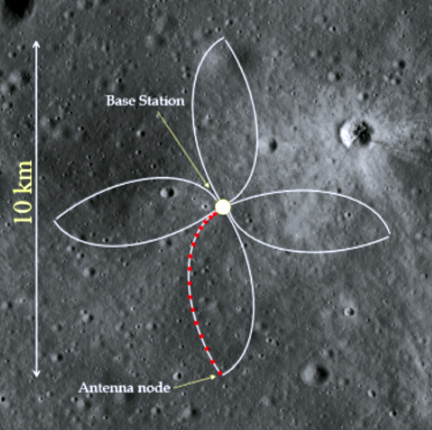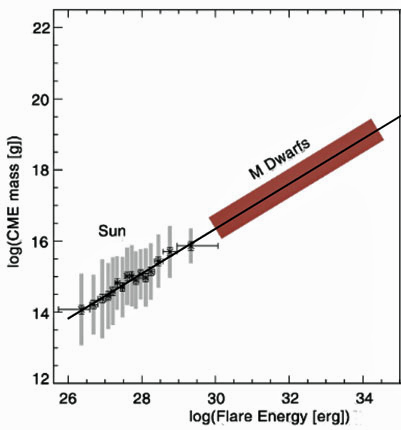|
This month, a team of scientists from Caltech/JPL, NASA, and other institutions proposed a $1.33 B observatory on the far side of the Moon.
It has become trendy to name major science projects with cool acronyms — FARSIDE stands for Farside Array for Radio Science Investigation Into Dark ages and Exoplanets. I wonder how long they spent thinking that up.
FARSIDE will study:
1. The nearest “habitable” exoplanets
2. The Sun and its planets — known and suspected
3. The 21-cm-line to nearly the beginning of time
4. The Moon’s inner structure
5. And, the nearby interstellar medium
The far side of the Moon, the side that never faces Earth, is a prime site for radio telescopes. It is shielded from man-made interference and Earth’s AKR (auroral kilometric radiation) produced by solar wind electrons spiraling in our planet’s magnetic field (mostly near the poles). And, during lunar night, FARSIDE will also be shielded from the solar wind.
FARSIDE comprises a central base station, 128 RF (radio-frequency) antennas, and a rover. Without a direct line of sight to Earth, FARSIDE will utilize the planned, lunar-orbiting, NASA Gateway satellite to relay communications between the base station and Earth. This image shows the rover on the left and base station on the right.


After landing, the base station will deploy the rover to install all 128 antennas in a precise, slightly asymmetric, 6-mile (10 km) wide, pattern shown here.
Due to the Moon’s curvature, the rover and base station must communicate through the Gateway satellite, since they will be below one another’s horizon when they are more than one mile apart.
The base station provides power and control signals to the RF antennas, collects all their analog outputs, and performs interferometery by coherently combining waveforms. Each antenna comprises two orthogonal, 66-foot (20 m) wires that capture the two polarization directions of incoming radio waves. FARSIDE is sensitive to a frequency range of 0.2 to 40 MHz, over a field of view of 1/4 of the entire sky.
Let’s explore the scientific objectives, starting with exoplanets in nearby stellar systems.
There is great interest in the possibility of life beyond Earth. An essential requirement for life on potentially habitable exoplanets is their space weather.
NASA’s MAVEN mission showed that Mars once had oceans under a protective atmosphere. But by 4 billion years ago, the solar wind had blasted away almost all its atmosphere, resulting in the loss of all its oceans.
Earth avoided the same catastrophic fate because it has a remarkably large magnetic field that shields our atmosphere.
Whether or not an exoplanet can maintain an atmosphere depends critically on its magnetic field strength and on the intensity of its star’s flares and CMEs (coronal mass ejections).
Recent enthusiasm regarding exoplanets in “habitable” zones has focused on M dwarf stars, the smallest and most common type of star. Despite the fact that a great many other factors are also essential for life, in the parlance of planet hunters, “habitable” merely means a planet’s surface temperature might possibly lie between the freezing and boiling points of water.

Due to their low mass, M dwarfs radiate very little light, so their “habitable” zones are extremely close to the star. In a popular example, Trappist-1 has three exoplanets in its “habitable” zone that orbit 21, 26, and 34 times closer to their star than Earth does to the Sun. Proxima Centauri b, another favorite, orbits 20 times closer than Earth. Thus, the stellar radiation these exoplanets receive is 400 to 1100 times greater than they would receive if their orbits were as large as Earth's orbit.
Unfortunately for potential life, M dwarfs have very intense flares and CMEs. As this chart shows, M dwarfs radiate 1000 times more CME mass and 100,000 times more flare energy than our Sun, on an average basis.
The closer orbits and greater stellar activity mean exoplanets in the “habitable” zones of the most common stars can be exposed to millions of times more hazardous radiation than Earth.
Certainly we need to know more about these places before booking travel reservations.
For the 25 nearest stellar systems, FARSIDE can detect RF radiation from exoplanet AKR — stellar wind electrons spiraling in their magnetic fields. FARSIDE can also measure the flare and CME activity of their host stars. We will then know which exoplanets are not habitable and which are more promising.
Those of you who have read my books know I am pessimistic about the true habitability of exoplanets. I list 14 remarkable properties of Earth that support life. Not every one is absolutely essential, but I do believe every one of the 14 makes life much more likely. Other scientists have quite different views. Those whose jobs are finding alien life or new worlds to colonize are understandably more optimistic — they wouldn’t be investing their careers doing this if they weren’t.
If we are going to search the universe for truly habitable planets, FARSIDE is a fairly inexpensive way to eliminate bad choices.
In our next newsletter, we will explore other potential discoveries FARSIDE might achieve.

Best Regards,
Robert
July, 2019
Note: Previous newsletters can be found on my website.
|